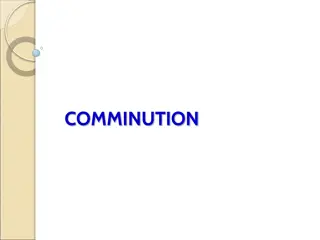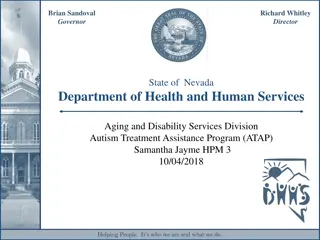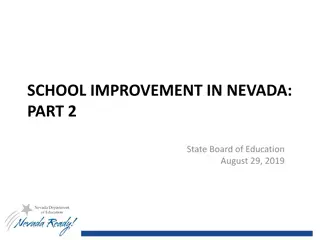Nevada Class-Size Reduction Program Overview
The Nevada State Board of Education implemented the Class-Size Reduction Act to reduce pupil-to-teacher ratios in early grades. Research shows mixed results on the effects of class-size reduction, with studies from various states highlighting different outcomes. The history of class-size reduction ratios in Nevada reveals the legislative actions taken over the years to define specific ratios for different grade levels.
Download Presentation

Please find below an Image/Link to download the presentation.
The content on the website is provided AS IS for your information and personal use only. It may not be sold, licensed, or shared on other websites without obtaining consent from the author.If you encounter any issues during the download, it is possible that the publisher has removed the file from their server.
You are allowed to download the files provided on this website for personal or commercial use, subject to the condition that they are used lawfully. All files are the property of their respective owners.
The content on the website is provided AS IS for your information and personal use only. It may not be sold, licensed, or shared on other websites without obtaining consent from the author.
E N D
Presentation Transcript
STATE OF NEVADA CLASS-SIZE REDUCTION PROGRAM State Board of Education August 29, 2019
Class-Size Reduction Enacted the Class-Size Reduction Act (CSR) in Assembly Bill (AB) 964, as a means to reduce pupil-to-teacher ratios in early grades where core curriculum is taught. Funding was first provided in Fiscal Year 1991. 2
Research on Pupil-Teacher Ratios Positive Effects Mixed Results Other Studies Tennessee STAR Study o 15:1 ( K-3) o Estimated effects largest for African Americans, economically disadvantaged, inner-city students, and boys California Class-Size Policy o 20:1 ( K-3) o Having a first-year teacher reduced student achievement by roughly the same amount as the 10-student reduction in class size increases in achievement National Education Longitudinal Study o Reduction by 10 (8th grade) o Modest overall positive effects on non-cognitive skills related to school engagement Texas Study o Natural Population Variation (4 -7 ) o Impacts on 4th & 5th grades; little or no effects on other grades Connecticut Study o Natural Population Variation (4 & 6) o Found no relationship between class size and student achievement in 4th and 6th grades Minnesota Study o Reduction by 10 (K-12) o Similar results as Tennessee STAR Study but smaller magnitude o Positive effects on reading and math (4th grade smaller effect in 5th grade; no effect in later grades Florida Class-Size Policy o 18:1 (PreK 3) o 22:1 (4-8) o 25:1 (9-12 o No positive effects of class-size reduction on student achievement o Improved non-cognitive outcomes for student (absenteeism and improved crime/violence)
History of Class-Size Reduction Ratios Date Legislative Action Prescribed Ratios 1989 AB 964 enacted the Class-Size Reduction Act (CSR). 15:1 in grades K-3 2005 SB 460 established alternative ratios for certain grades in districts whose population is less than 100,000. 22:1 in grades 1-3, and 25:1 in grades 4-6 (elementary school) 2010 AB 4 (Special Session) temporarily provided flexibility from the requirements of CSR , also known as the Plus-Two Program , in response to the recession. 18:1 in grades 1-2, and 21:1 grade 3 2013 AB 2 (Special Session) revised ratios in statute. 16:1 in K-2 and 18:1 in grade 3 2015 SB 522 discontinued the Plus-Two Program . 16:1 in grades 1-2, and 18:1 in grade 3 4
Baseline Ratios Prior to implementation, baseline ratios were established over the three academic years (1987-1990). Baseline ratios are used to determine funding amounts. CSR funds are generally used to maintain existing CSR teaching positions. Fiscal Year Total Number of Positions Funded Existing CSR Positions Funded New CSR Positions Funded 2015 1,858 1,788 70 2016 1,871 1,858 13 2017 1,928 1,871 57 2018 1,869 1,869 0 5
District Responsibility: Annual Plan Districts, excluding Esmeralda: Submit a plan to the Superintendent of Public Instruction Describing how prescribed ratios will be reduced to 17:1 in grades 1-2 and 20:1 in grade 3 Or, districts in counties with populations less than 100,000 may: Submit an alternative plan to the State Board of Education Describing the efforts taken to reduce the district s ratios to 22:1 in grades 1-3 and 25:1 in grades 4-6 6
District Responsibilities: Reporting Provide quarterly reports of the average daily enrollment (ADE) and class-size ratios. If needed, request necessary variances from the State Board of Education for the next quarter for each elementary school Identify the reason for the request (enrollment changes) Justify the need to exceed the prescribed ratio of pupils per class Could include: facility limitations, difficulty hiring, lack of available funding, fiscal neutrality Post on the district website: ADE and class-size ratios for each elementary school Identify schools that have been granted variances 7
Current Financial Authority The funding bill indicates that districts: may not expend CSR funds until the Superintendent of Public Instruction has approved the annual plan, and Must demonstrate that a sufficient number of teachers have been employed to maintain the baseline ratios (1987-1990) from resources other than CSR funding. The Superintendent of Public Instruction may withhold a portion of a district s DSA Basic Support amount based on the percentage of pupils attending classes that exceed the maximum allowed ratio, If the Superintendent of Public Instruction finds that the district has NOT made every reasonable effort in good faith to comply with the applicable standard and the State Board of Education concurs. If the State Board of Education denies a district s request for variance: the district would need to hire additional teachers to reduce its class sizes to the required levels or, be out of compliance with state law. 8
Future Considerations Statutory Funding Reporting Evaluation 9
Future Statutory Considerations Expand reporting requirements as outlined in NRS 388.710 State Board of Education to determine data to be monitored by school district; school district to report data to State Board. 1. The State Board, in consultation with the trustees of the school districts and the recognized associations representing licensed educational personnel, after receiving comments from the general public, shall determine the data that must be monitored by each school district and used to measure the effectiveness of the implementation of a plan developed by each school district to reduce the pupil-teacher ratio pursuant to NRS 388.720. 2. Each school district shall report the data to the State Board as required by the State Board. (Added to NRS by 1989, 2106; A 2005, 2162) 10
Future Funding Considerations Align funding with requirements legislatively: Currently funding is provided at the district level, while class-size ratio and variance request reporting is at the school level Currently, funding is provided at a statewide average salary and benefit cost 11
Future Reporting Considerations Revisit reporting policies: Evaluate class size ratios using whole numbers Is ADE the best measure of class size? Quarterly reports vs. annual reports 12
Additional Evaluation Considerations Fund and conduct a statewide evaluation to determine the impact of class size reduction efforts in each grade (1-3). Additional analysis of variances: Are there trends that can be addressed long term? 13
Questions? 14























